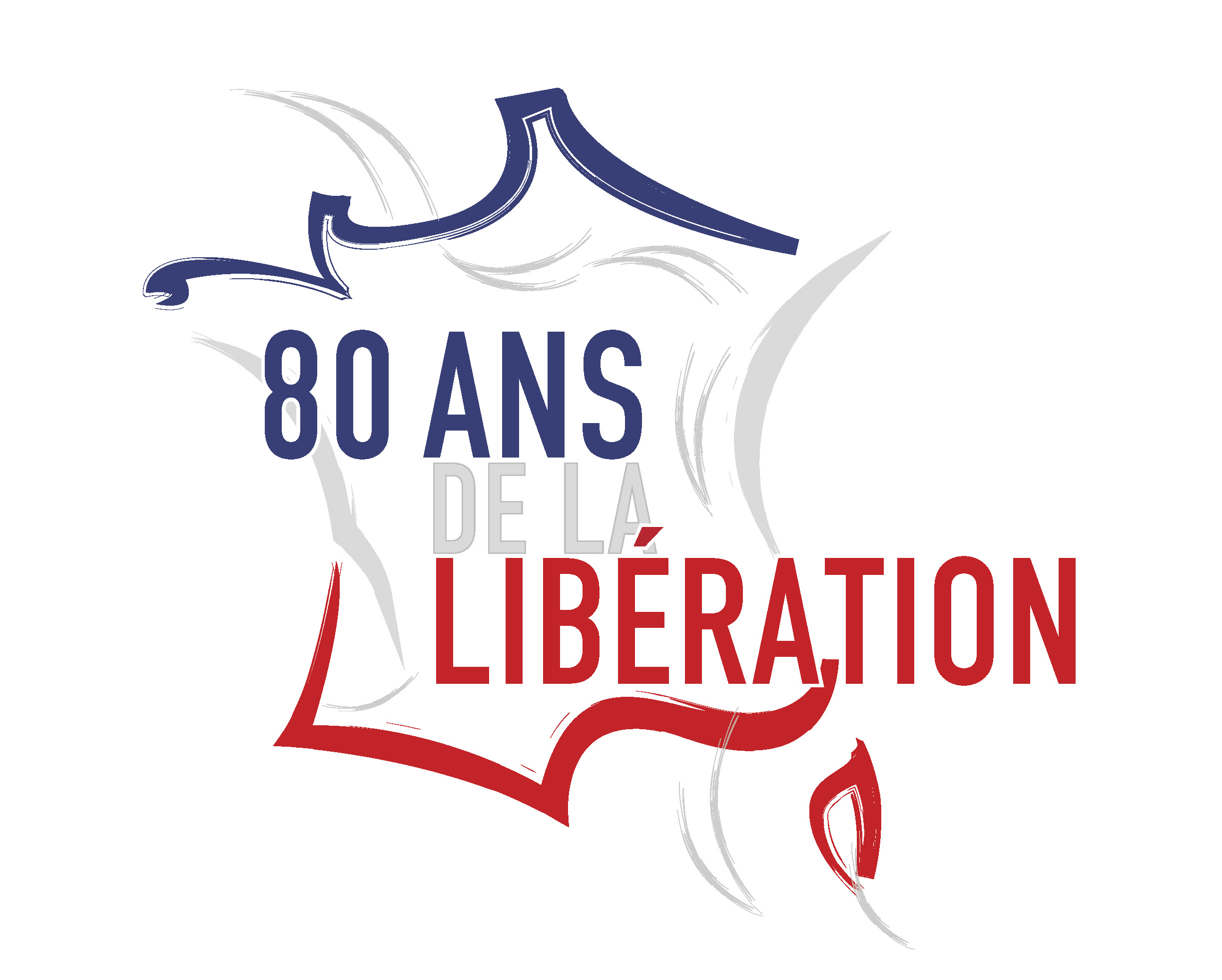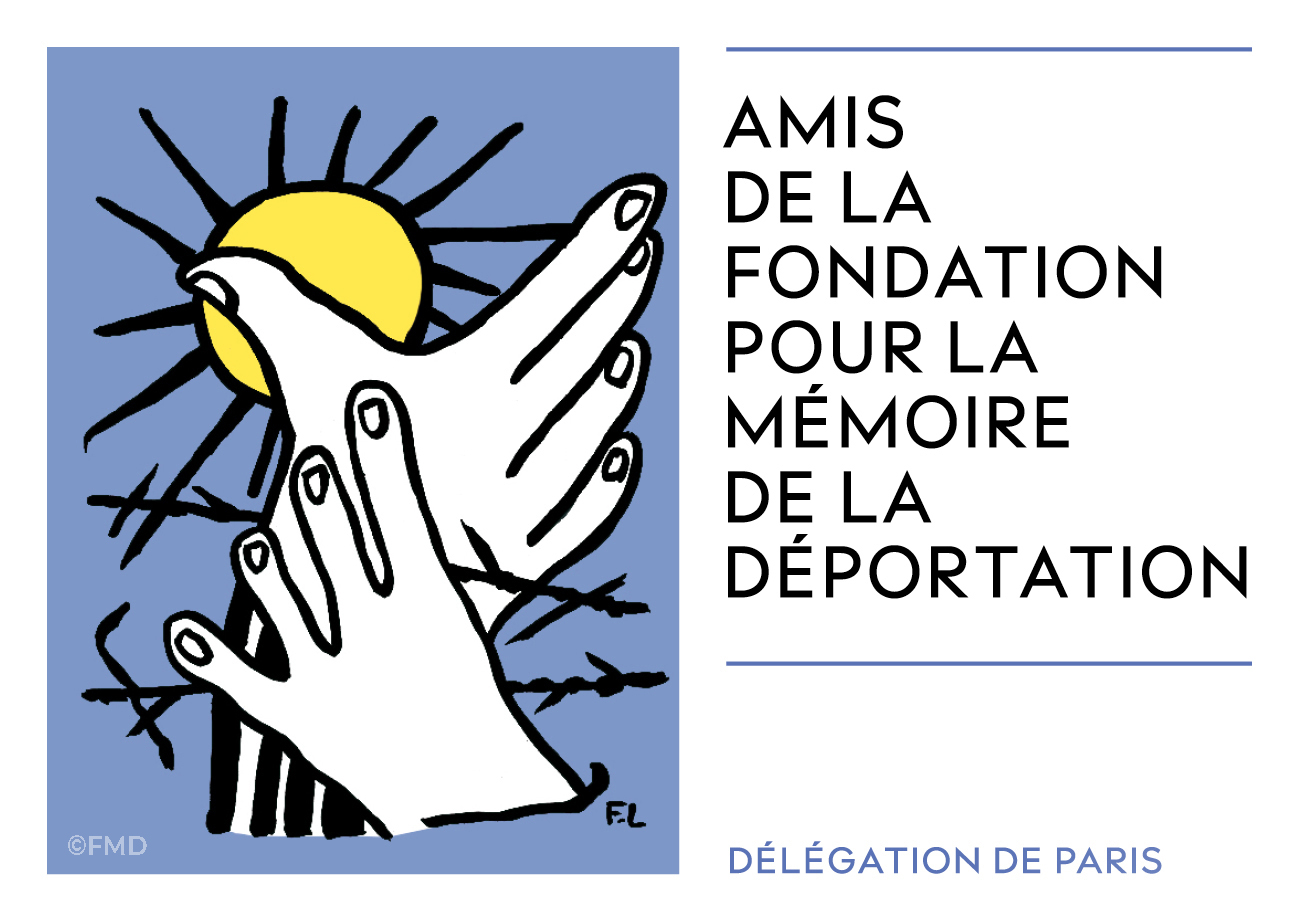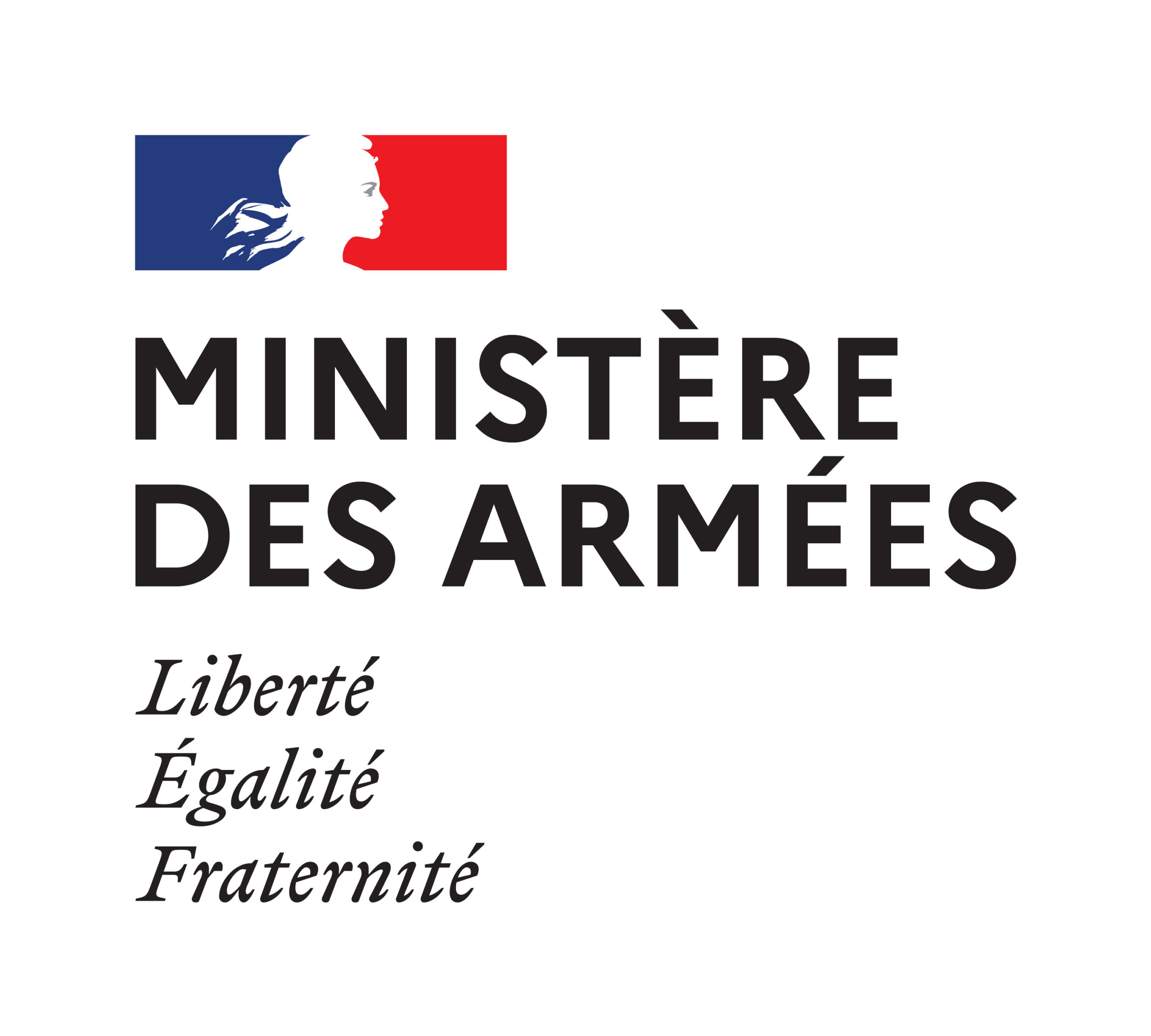MAUTHAUSEN
Opened in August 1938
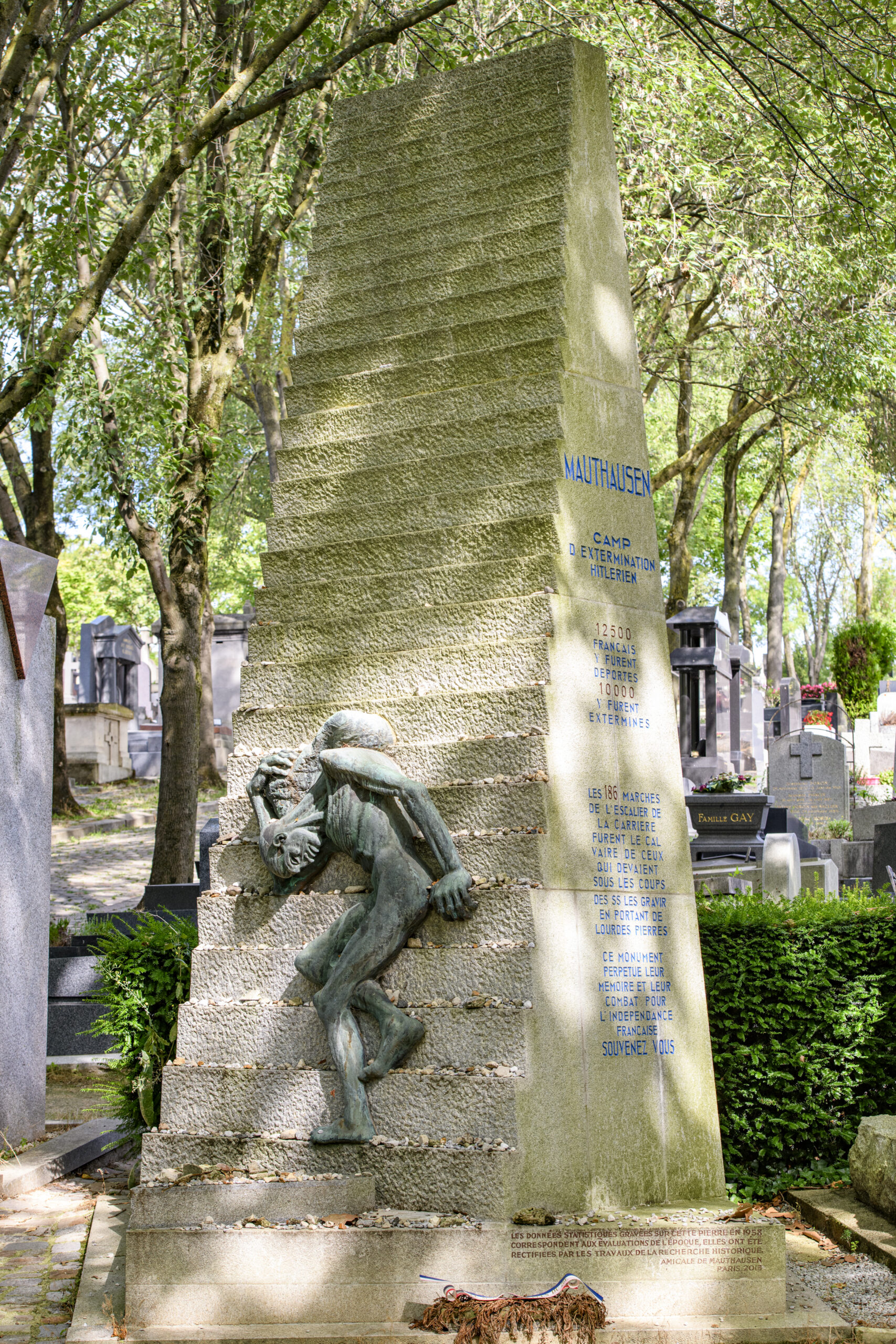
© Vincent Gerbet
Monument description
Inaugurated on 4 May 1958, this monument is a reminder of the granite quarry at the Mauthausen camp. The steps evoke the 186 steps of the staircase in this quarry that the deportees had to climb by carrying the heavy stones, under the blows of the SS. The granite was extracted from this Austrian quarry.
The bronze man, sculpted by Gérard Choain and cast by Marius Hohwiller, is a representation of a naked, emaciated deportee, having to carry a stone that is always too heavy for exhausted bodies. Frozen at the foot of the steps, the man seems unable to go any further. This monument is first and foremost a tribute from the survivors to their fallen comrades.
On the left side of the monument is inscribed :
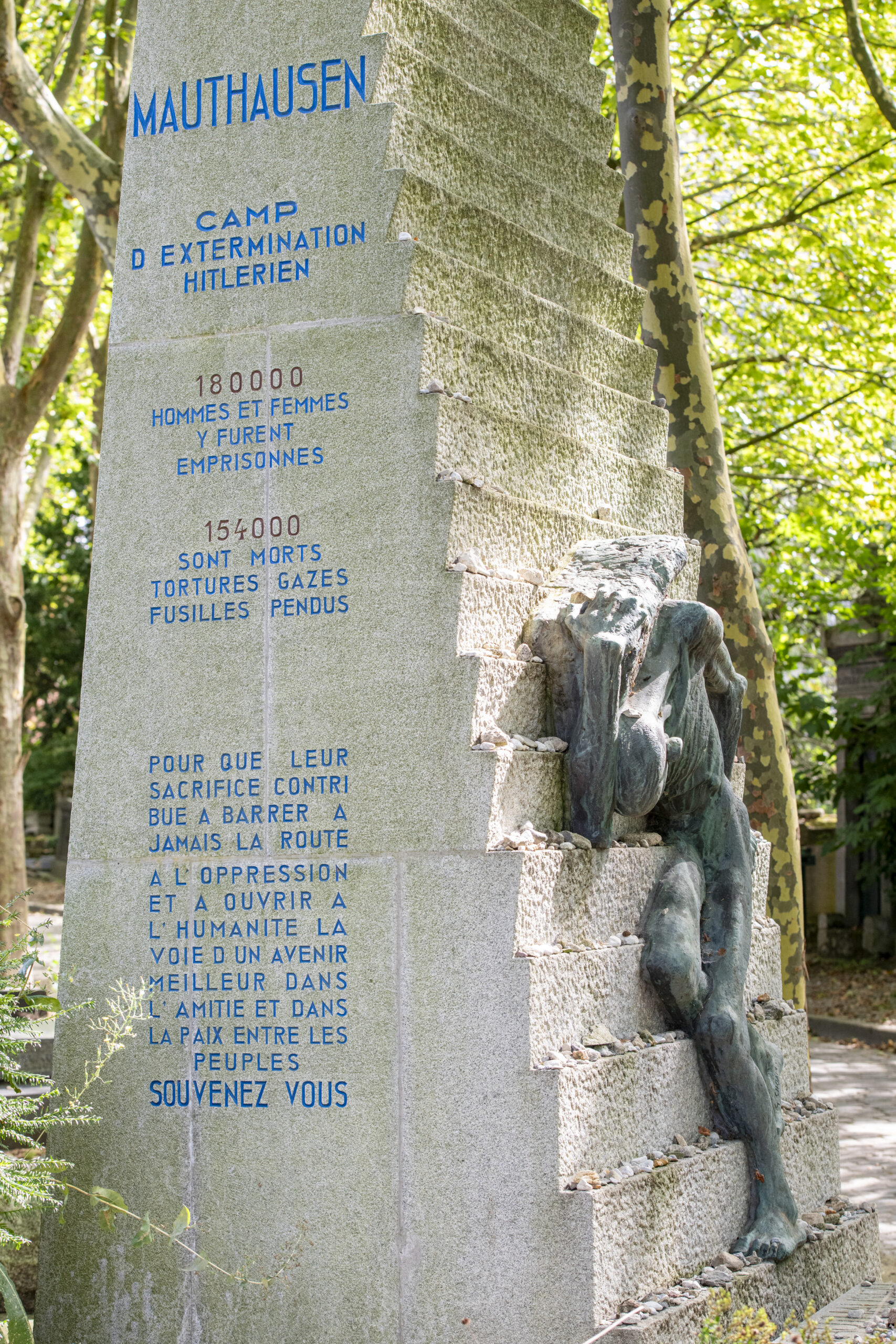
© Vincent Gerbet
MAUTHAUSEN
Hitler’s extermination camp
180,000 men and women were imprisoned there.
154,000 died, tortured, gassed, shot or hanged.
So that their sacrifice may contribute to forever blocking the road to oppression and to opening the way for humanity to a better future in friendship and peace between peoples
REMEMBER
On the right-hand side is written :
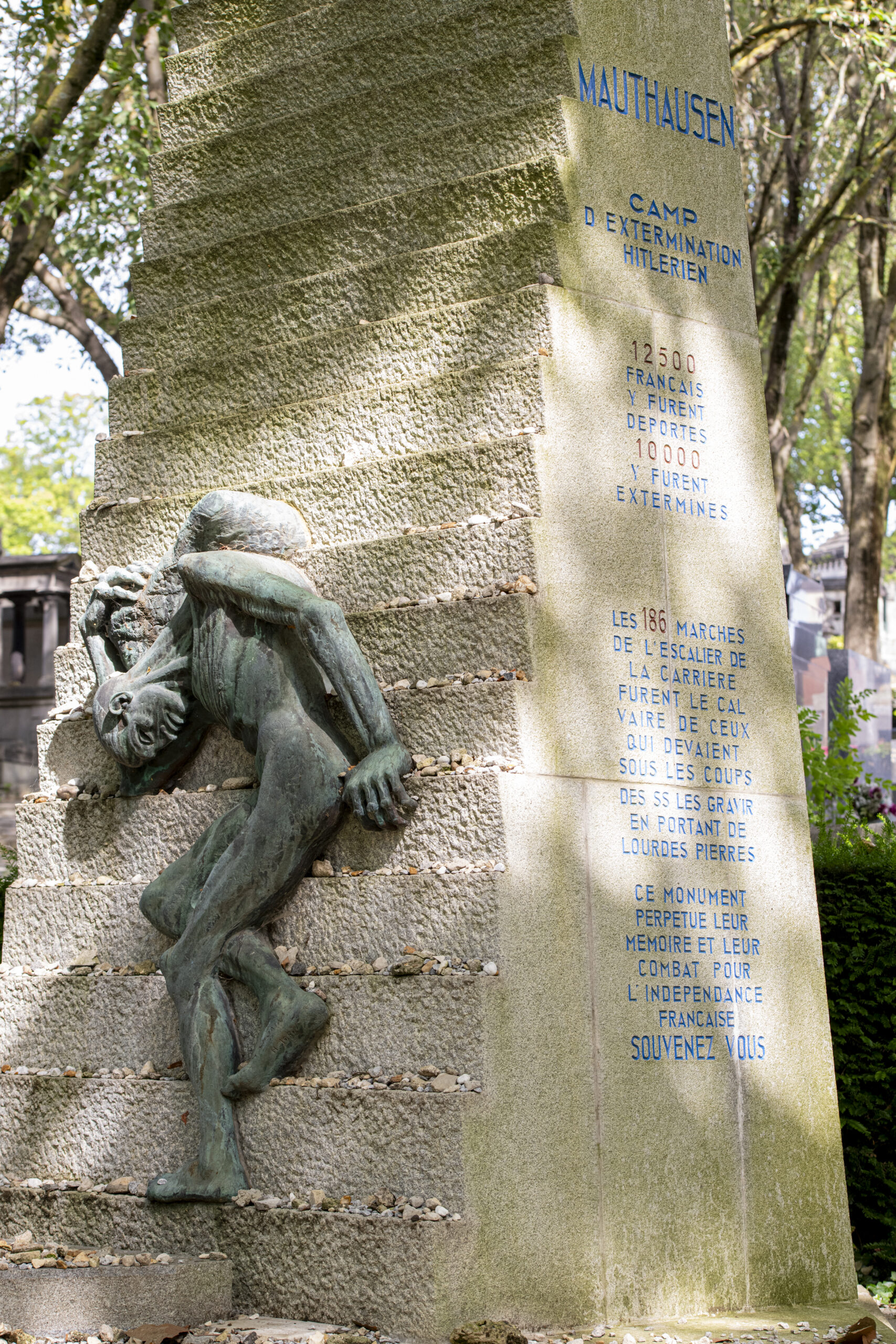
MAUTHAUSEN
Hitler’s extermination camp
12,500 French nationals were deported there
10,000 were exterminated
The 186 steps of the quarry were the ordeal of those who had to climb them carrying heavy stones under SS fire.
This monument commemorates them and their fight for French independence.
REMEMBER
At the back of the monument, the top of which is surmounted by the insignia of the French political deportees, it is inscribed :
The Mauthausen extermination camp is located 25 km from Linz (Austria).
It was liberated on 5 May 1945
On the side of the plinth, the Amicale française de Mauthausen was keen to correct the estimates known at the time of the monument’s inauguration :
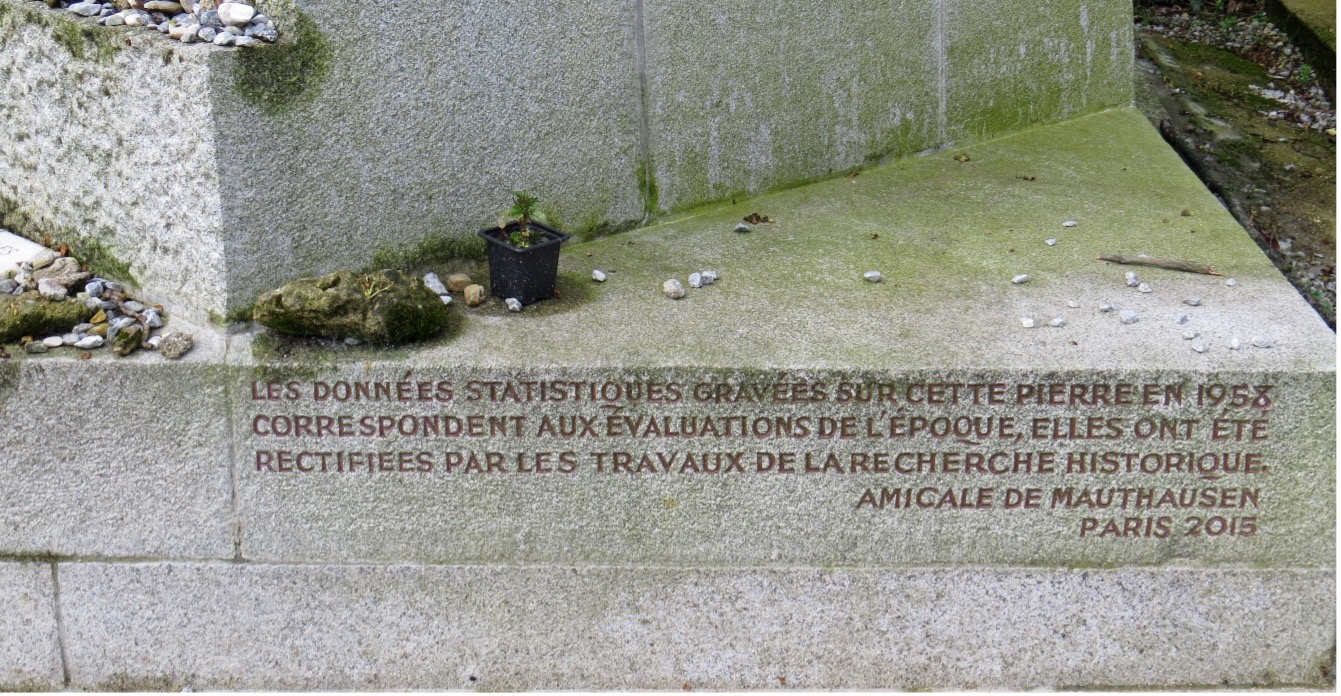
In 2024, the minimum estimate of the number of deportees in the Mauthausen complex and its kommandos was 198,000, including 4,900 women, of whom 158,850 were given a matricule number in this camp.
Mauthausen camp
Mauthausen is a village on the left bank of the Danube, 22 km from Linz (Hitler’s home town).
The camp opened in August 1938, a few months after Hitler’s Anschluss (annexation of Austria) on 12 March 1938.
The choice of location was dictated by the proximity of the Danube and railway lines, but above all by the presence of a granite quarry owned by the city of Vienna. The granite was used to pave the streets of Vienna and other German cities under the authority of Albert Speer, Hitler’s architect. Hitler wanted to rebuild cities such as Frankfurt, Munich and Linz, but his wildest dream was to create a new capital for the thousand-year-old Reich: « Germania ».
This camp would take the form of a medieval « fortress » built from granite stones hauled up a 186-step staircase on the hill overlooking the quarry: this was the first project the prisoners were asked to undertake.
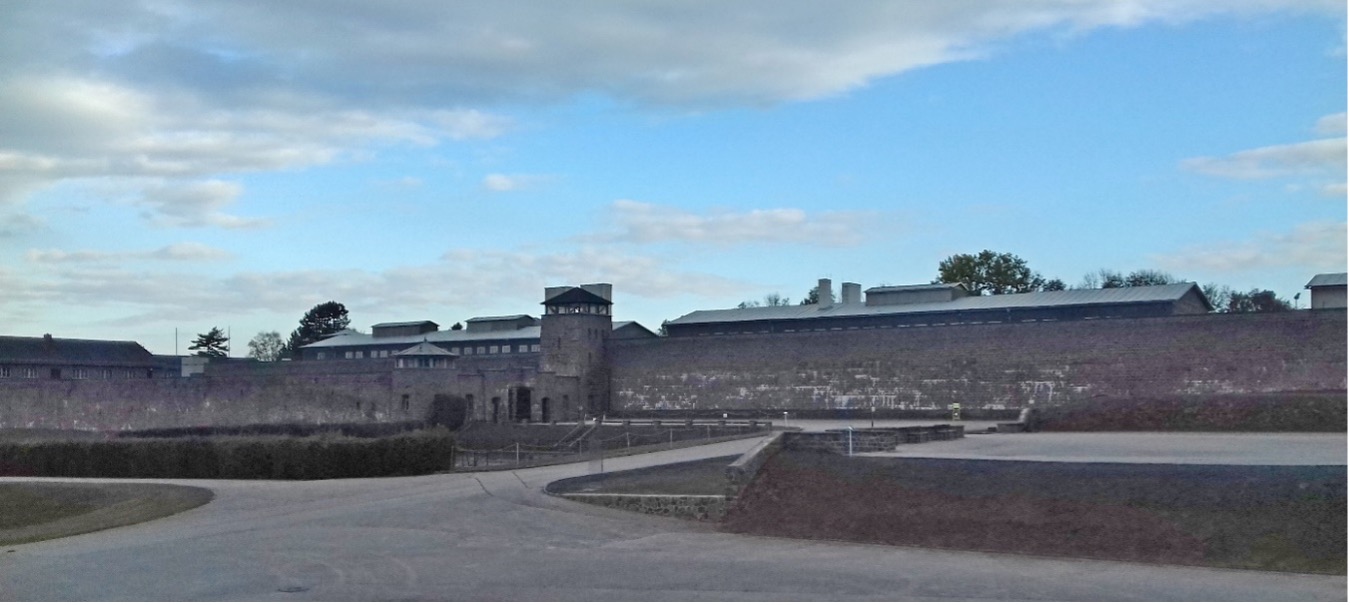
The « fortress » of Mauthausen
© AFMD 75
Practically all the inmates work in the quarry. They descend the « stairway of death » in rows, five by five, 186 steps apart and of unequal height, and climb back up with heavy granite blocks on their backs. Sometimes¸ judging the blocks to be too small, the SS force them back down to grab a bigger one.
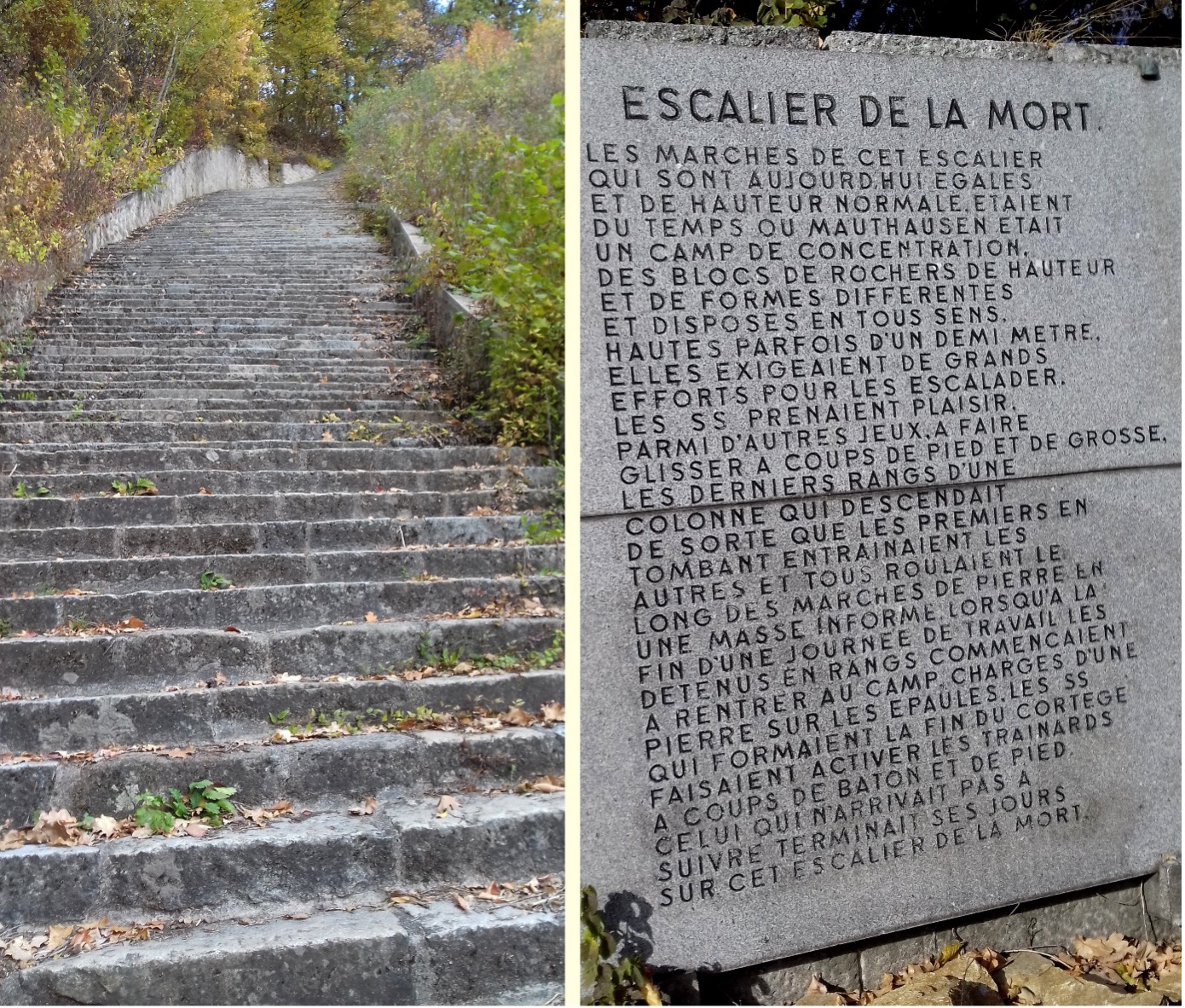
© AFMD 75
The SS often threw the men from the top of the stairs (over a hundred metres high) or asked them to fight, promising the victor their lives.
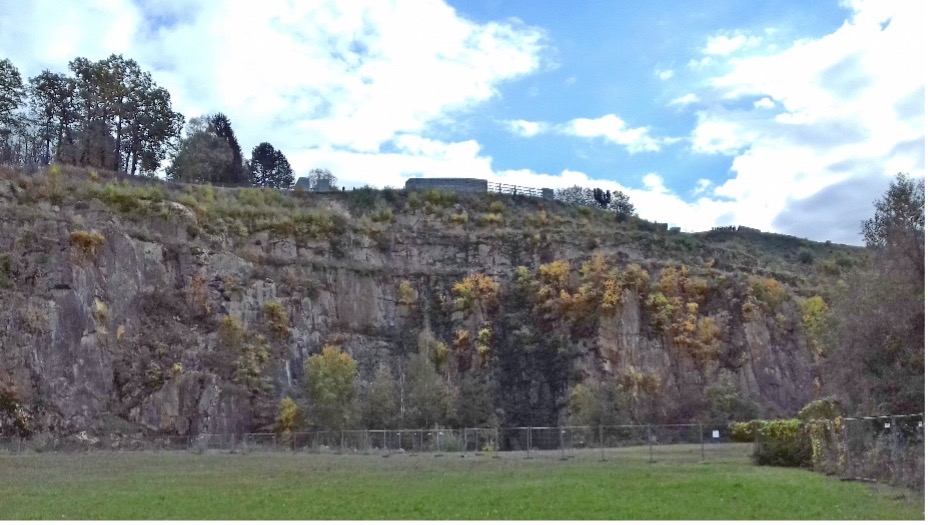
The quarry
© AFMD 75
In the winter of 1941, the Kommandantur, the Appellplatz (call square), the SS garages (with the imperial eagle on the entrance door), the Bunker (prison), the crematoria, the gas chamber and the first twenty detention barracks were built within the walls.
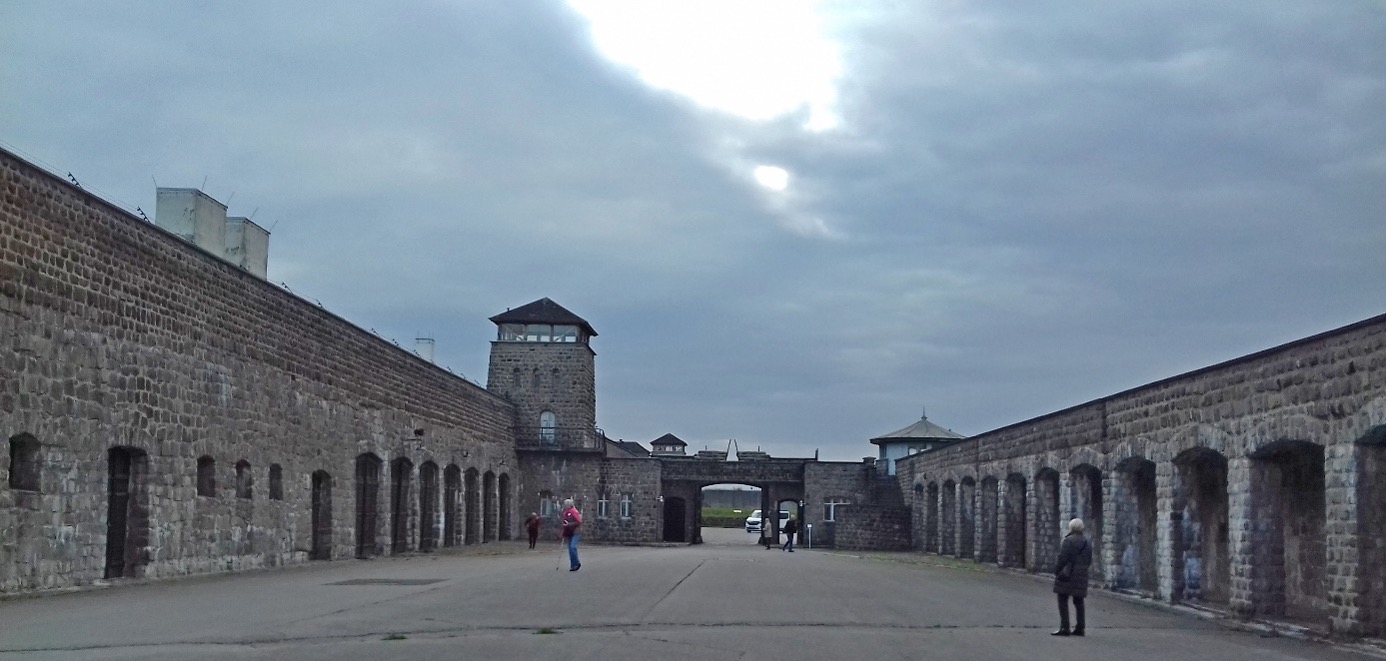
Inside the enclosure
© AFMD 75
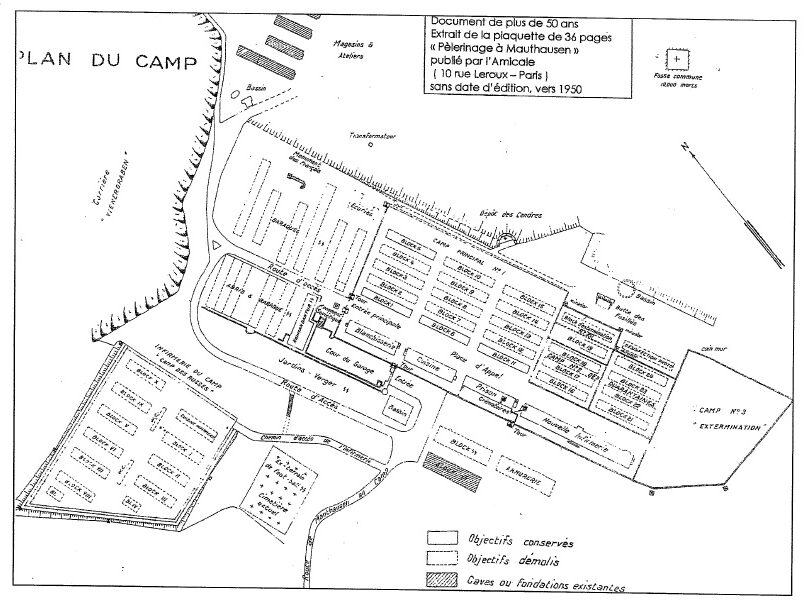
Map of the camp drawn in 1950
© Amicale de Mauthausen France
The inmates
After the arrival of a kommando from Dachau in 1938, Austrian opponents were sent to Mauthausen, followed by Czechoslovakians after the annexation of the Sudetenland and Poles. At the beginning of August 1940, the Spanish Republicans arrived : almost 7,200 Spanish Republicans, interned in France or taken prisoner following their enlistment in the French Army, were deported to Mauthausen. The first transport from France took place on 6 August 1940.
In 1942, after the defeat at Stalingrad, the need for manpower became an absolute necessity for the arms industry (see Aktion Meerschaum), and the concentration camp population expanded far beyond political opponents : STO draft dodgers, hostages and random roundups, convicts under common law, Soviet prisoners of war destined for mass extermination, gypsies and Jews transferred from Auschwitz from May 1944.
Soviet prisoners of war had to stand still, doused in icy water in the middle of winter, and froze in place.
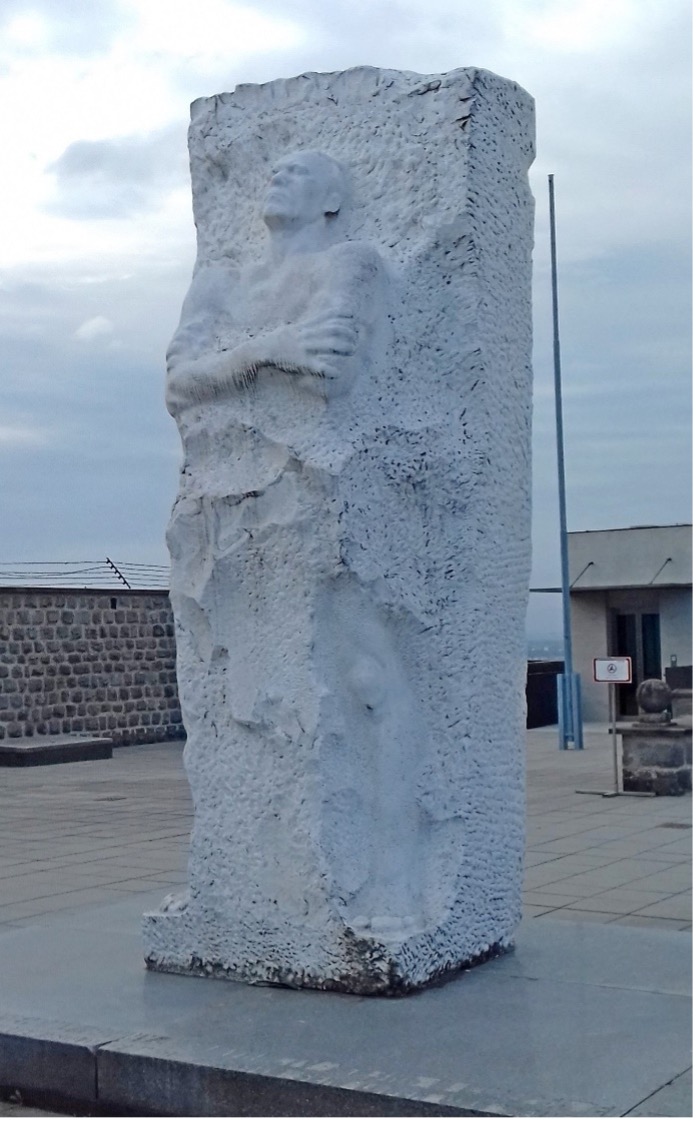
Monument to the Soviets
© AFMD 75
Mauthausen was the only camp, along with its sister camp at Gusen (see below), to be classified as level III – which meant that the conditions of detention had to be the harshest in the entire National Socialist concentration camp system. It therefore received NN (Night and Fog) deportees (see Keitel’s decree of December 1941), who were to disappear without a trace.
At the end of the war, as the other camps were evacuated, NN deportees from these camps were transferred to Mauthausen, including many women.
Between August 1938 and May 1945, more than 198,000 prisoners of over 20 nationalities passed through Mauthausen, including nearly 8,800 French men and 600 French women
– some 120,000 were murdered.
Medical experiments and executions
Numerous medical experiments were carried out in the Revier at Mauthausen and Gusen: injections of phenol, research into vaccines against cholera and typhus, unnecessary surgical operations, executions in the Mauthausen gas chamber using Zyklon B of sick people, Yugoslavs and Jews, or in Gusen in gas lorries.
In 1938, Aktion T4 was set up, a campaign of extermination by murder of physically and mentally handicapped German and Austrian adults, carried out under the direction of the T4 Central Office of the Führer’s Chancellery: 70,000 to 80,000 victims.
Hartheim Castle, a former insane asylum 40 km from Mauthausen, became a euthanasia centre in March 1940 for the physically and mentally disabled, the incurably ill, bedridden or simply people who could no longer work: 30,000 people were murdered, gassed or cremated there between 1940 and 1944, their ashes thrown into the Danube.
In August 1941, Aktion T4 was replaced by Aktion 14f13. From 1941 onwards, invalid prisoners unfit for work from Mauthausen, Gusen, Dachau, Buchenwald and Ravensbrück were transported in special buses to be murdered at Harteim.
In this castle, 70 civilians, caretakers, office staff, crematorium workers, bus drivers, photographers, cooks and professional careers, were put in charge of the bureaucratic implementation of the killing operation.
Many of these staff had been recruited from the region !
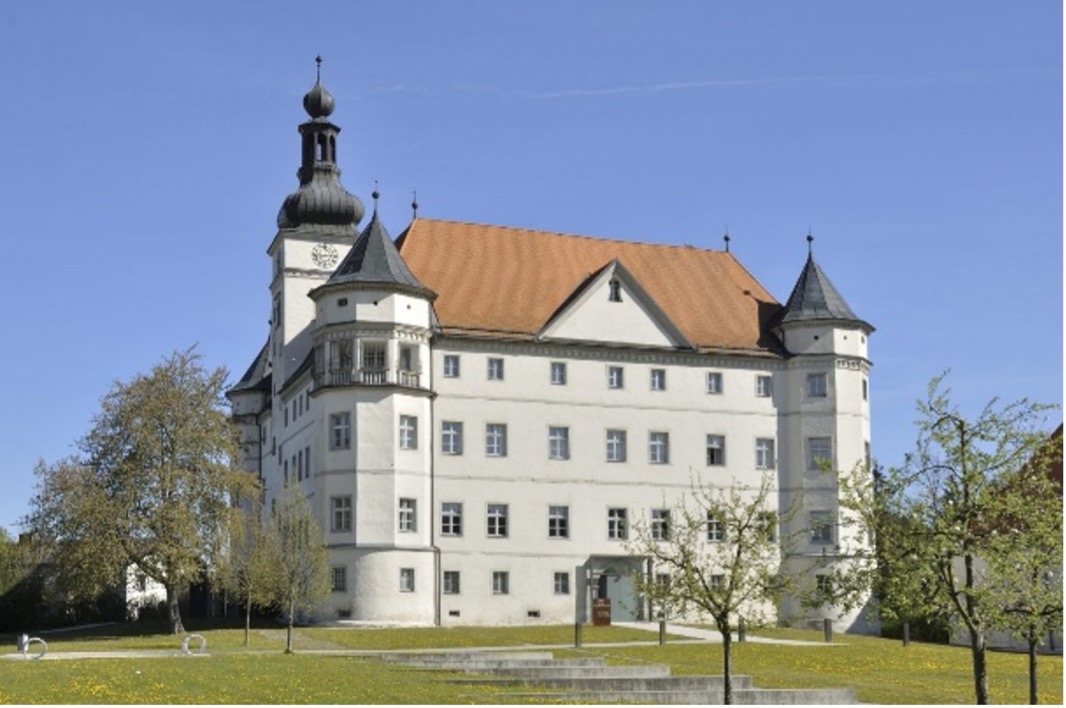
Hartheim Castle
© DR
In mid-December 1944, the Nazis sent a kommando of Spanish and Polish masons from Mauthausen to destroy all traces of the gassing installations. The demolition and camouflage work was completed in January 1945.
Work Kommandos
At Mauthausen, the Messerschmitt factory used deportees from 1943 onwards.
The camp had 46 kommandos.
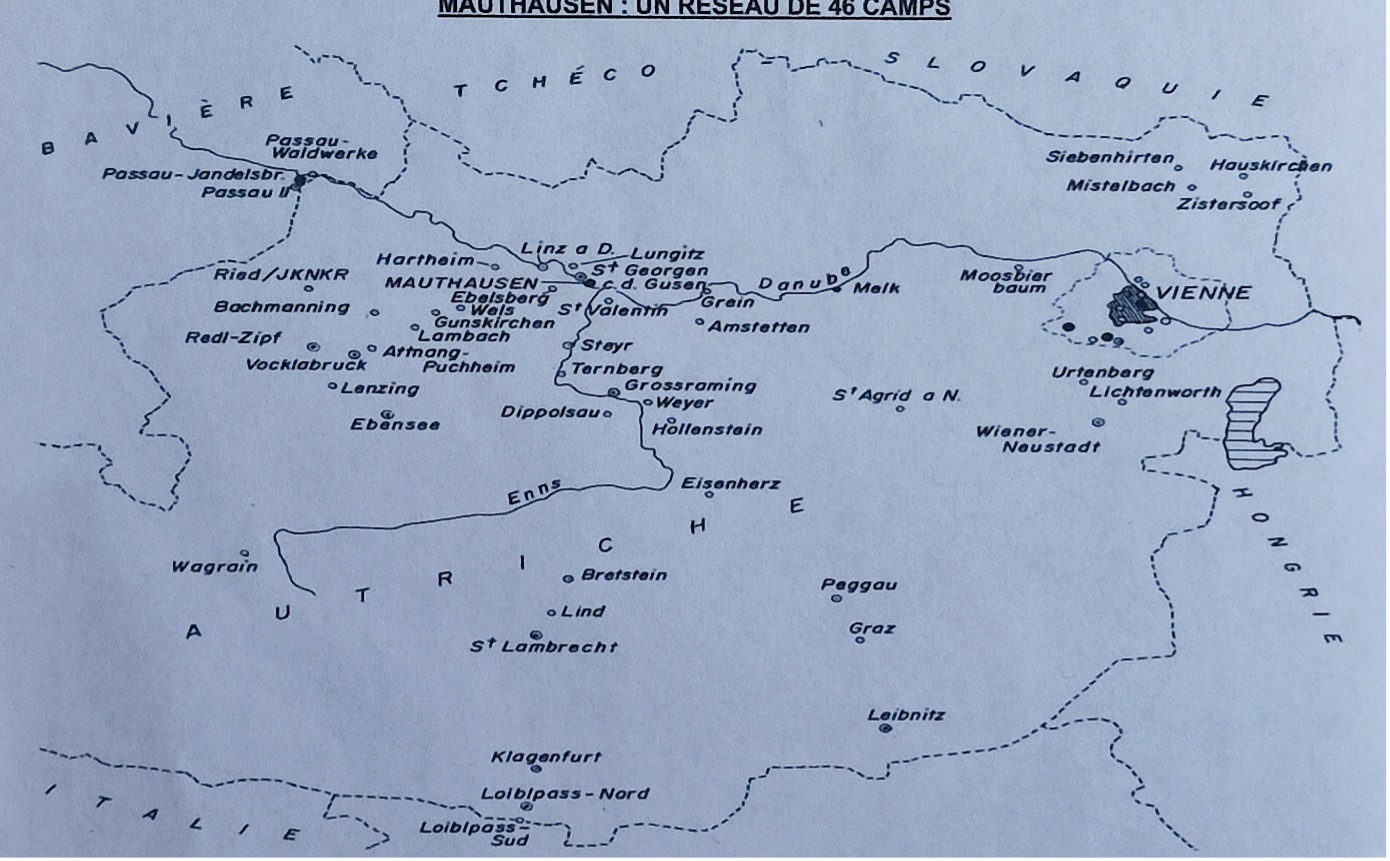
The most important were:
GUSEN
The name of a quarry, a hamlet and a tributary of the Danube.
This camp, created in December 1939 and brought into service on 25 May 1940, became GUSEN I. The prisoners worked in the granite quarries. At the beginning of 1943, they were also employed in the arms industry by Steyr-Daimler-Puch and Messerschmitt GmbH.
In March 1944, GUSEN II came into operation, to house underground production of the V1 and V2 and the Me262 (the first fighter plane). In December 1944, GUSEN III was created, with deportees working on the brickworks and building a bakery to supply the various camps. GUSEN III was used as a warehouse for building aircraft.
More than 71,000 prisoners from over 27 nations were interned there.
More than half of them died.
After the liberation, a very large part of the camp was razed to the ground in a short space of time.
In the 1960s, international survivors’ organisations, at their own expense, erected a monument around the crematorium, which has since been preserved. The « Gusen Memorial » was inaugurated in 1965. Today, very little remains of the camp and large parts of the site have been used to build a housing estate!
EBENSEE
Located 100 km south-west of Mauthausen, in the Traun valley surrounded by mountains, opened on 18 November 1943.
Its creation was intended by Hitler as an alternative location to Peenemünde for the manufacture of V2 ballistic missiles. Prisoners were employed to dig tunnels in the mountains to hide them. Digging them was particularly exhausting and dangerous. Around 1,000 German civilians had a dozen prisoners at their disposal. The missiles were never produced…
Instead, these tunnels were used by the « Zement project » to house a synthetic oil refinery (Tunnels A) and workshops to manufacture tank parts and tanks for Daimler (Tunnels B).
The crematorium went into operation on 31 July 1944, when the camp had fifteen barracks for 6,000 inmates, rising to 9,000 by December.
On 6 May 1945, the camp was liberated by American tanks : the A tunnels were almost ready, and some were already equipped; the B tunnels were 60% excavated. In total, 10 km of tunnels. All the documents were burnt by the Nazis.
Shortly after the end of the war, the concentration camp was dismantled and largely divided up to build private villas. All that remains is the entrance to the camp…
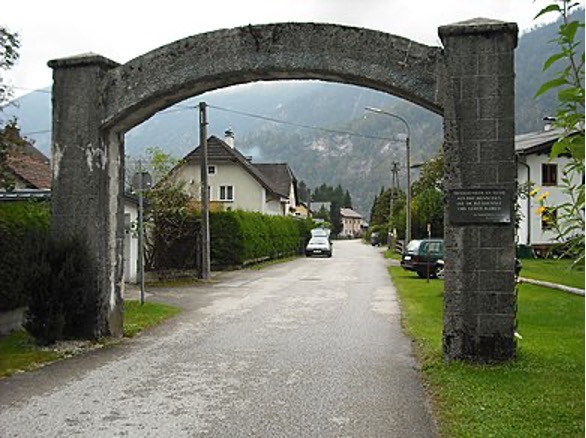
Current camp entrance
© AFMD 75
In total : 18,509 prisoners of 23 nationalities (including 8% French)
More than 8,500 victims died.
LOIBL-PASS (Ljubelj)
Located 300 km from Mauthausen, the Loibl-Pass links Austria to Yugoslavia (now Slovenia).
In 1942, construction of the tunnel was started by Slovenian and Croatian civilians working for a company in Vienna.
At the beginning of June 1943, the first prisoners arrived to complete the construction. The first camp, the « southern camp », was set up on the Yugoslav side, the second, the « northern camp », on the Austrian side.
The two tunnels were joined on 4 December 1943.
The first German vehicles drove through a year later.
Within two years, the workforce had grown to around 1,800 men of 10 nationalities.
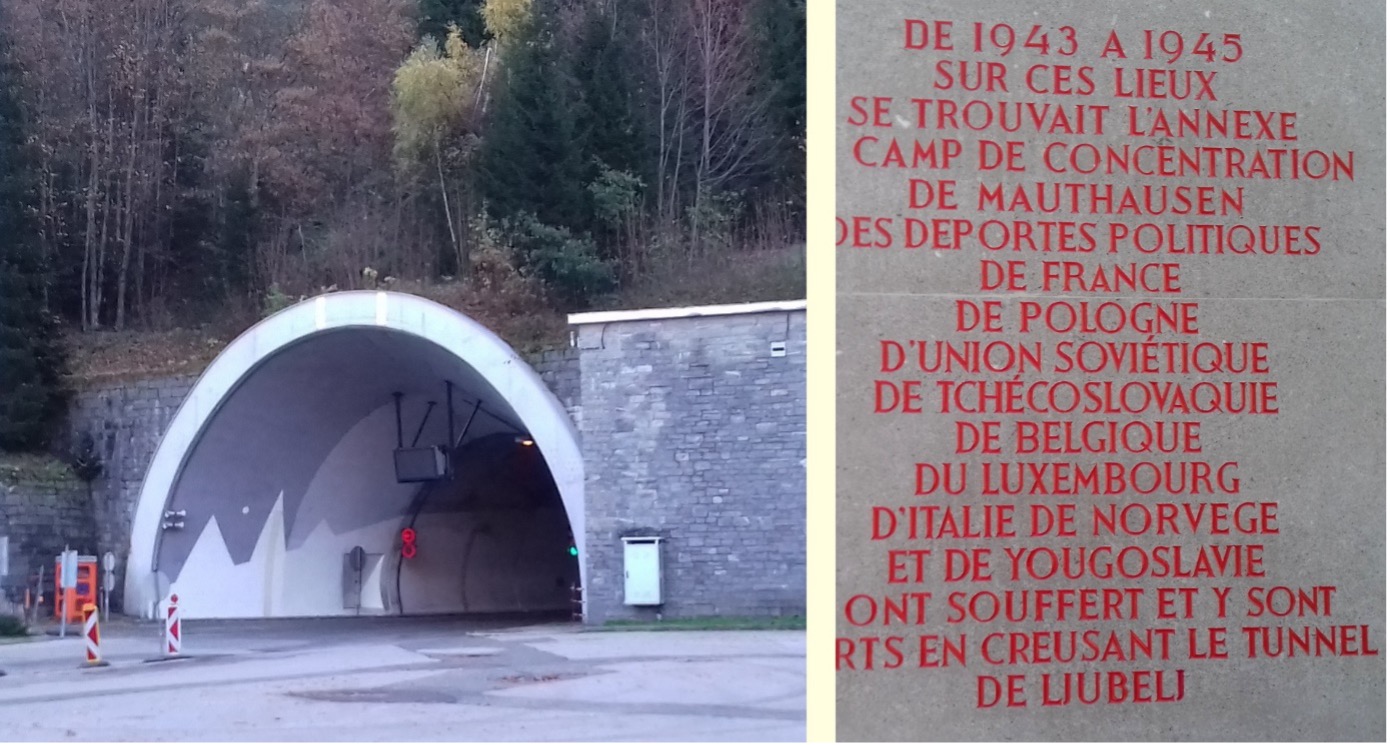
Entrance to the current tunnel
© AFMD 75
On 7 May 1945, the deportees evacuated the camp and were liberated in Austria by Marshal Tito’s Partisans. The following day, 122 French survivors stayed on to fight with Tito’s Partisans and formed the Freedom Brigade.
MELK
In April 1944, prisoners were assigned to this former engineering barracks to produce ball bearings for the Steyr-Daimler-Puch company.
On 21 April 1944, the first convoy of 500 deportees arrived (420 French, 30 Spanish and 30 Germans).
Then on 23 April, 532 Frenchmen arrived from Mauthausen. More inmates arrived every week. Around 1,500 French people were held at Melk, and the first to arrive occupied important positions in the internal hierarchy.
Inscription on the French monument to the Mauthausen central camp in Austria :
« The dead do not sleep; they have only this stone, powerless to bear the crowd of their names.
The memory of the crime is the only prayer we ask of you, passer-by ».
Sources
– Amicale française de Mauthausen : https://campmauthausen.org
– Mémorial de Mauthausen en Autriche : https://www.mauthausen-memorial.org
– DEBRISE (DREYFUS) Gilbert, Cimetières sans tombeaux, préface d’Aragon. Ed. La Bibliothèque française, 1945.
– FABREGUET, Michel, Mauthausen, camp de concentration national-socialiste en Autriche rattachée, éd. Honoré Champion, 1999
– FREUND, Florian, Ebensee-Kommando de Mauthausen. Souvenirs de rescapés, édition revue et augmentée. Amicale de Mauthausen. Paris, 2016
– LACAZE, André, Le tunnel. Ed. Julliard,1978
– LAFFITTE, Jean, Ceux qui vivent, Ed. Hier et Aujour’dhui, 1947 ; rééd. Les Editeurs français réunis, 1958.
– LEE, Adeline, Les Français à Mauthausen-Par-delà la foule de leurs noms, éd. Tallandier, Paris, 2021
– SCHWANNINGER, Florian, Le château de Hartheim et le « Traitement spécial 14f13 », Revue d’Histoire de la Shoah, 2013/2 (N° 199)
– TESSIER, Christian et DEDET, Daphné, Du Loibl Pass à la brigade Liberté, éd. La clé du chemin, 2015
– TILLARD, Paul, Le pain des temps maudits, éd. Julliard, 1965
– Zeitgeschichte Museum Ebensee- Camp de concentration d’Ebensee. Catalogue d’exposition 1999
– http://www.melk-memorial.org
– http://www.schloss-hartheim.at/
– https://memorial-ebensee.at/website/index.php/fr/memorial-fr
– http://jsegalavienne.wordpress.com/2010/11/12/un-film-qui-en-dit-long/
– https://collections.ushmm.org : DÜRR Christian, Lechner Ralf, Wolfinger Stefan, Camp de concentration de Gusen 1939-1945, Traces-Fragments-Reconstruction, éd. KZ- Gedenkstätte Gusen,1967
– https://afmd.org/en/loibl-pass-9379html
– http://www.danube-culture.org/le-chateau-de-hartheim-bei-alkoven-centre-deuthanasie/
– https://www.memoiredeshommes.sga.defense.gouv.fr/fr/article.php?larub=470
– https://www.gusen-memorial.org/fr
– https://www.cairn.info/revue-d-histoire-de-la-shoah
– https://fr.wikiital.com/wiki/Campo_di_concentramento_di_Ebensee
Mauthausen
Opened in August 1938

© Vincent Gerbet
Monument description
Inaugurated on 4 May 1958, this monument is a reminder of the granite quarry at the Mauthausen camp. The steps evoke the 186 steps of the staircase in this quarry that the deportees had to climb by carrying the heavy stones, under the blows of the SS. The granite was extracted from this Austrian quarry.
The bronze man, sculpted by Gérard Choain and cast by Marius Hohwiller, is a representation of a naked, emaciated deportee, having to carry a stone that is always too heavy for exhausted bodies. Frozen at the foot of the steps, the man seems unable to go any further. This monument is first and foremost a tribute from the survivors to their fallen comrades.
On the left side of the monument is inscribed :

© Vincent Gerbet
MAUTHAUSEN
Hitler’s extermination camp
180,000 men and women were imprisoned there.
154,000 died, tortured, gassed, shot or hanged.
So that their sacrifice may contribute to forever blocking the road to oppression and to opening the way for humanity to a better future in friendship and peace between peoples
REMEMBER
On the right-hand side is written :

MAUTHAUSEN
Hitler’s extermination camp
12,500 French nationals were deported there
10,000 were exterminated
The 186 steps of the quarry were the ordeal of those who had to climb them carrying heavy stones under SS fire.
This monument commemorates them and their fight for French independence.
REMEMBER
At the back of the monument, the top of which is surmounted by the insignia of the French political deportees, it is inscribed :
The Mauthausen extermination camp is located 25 km from Linz (Austria).
It was liberated on 5 May 1945
On the side of the plinth, the Amicale française de Mauthausen was keen to correct the estimates known at the time of the monument’s inauguration :

In 2024, the minimum estimate of the number of deportees in the Mauthausen complex and its kommandos was 198,000, including 4,900 women, of whom 158,850 were given a matricule number in this camp.
Mauthausen camp
Mauthausen is a village on the left bank of the Danube, 22 km from Linz (Hitler’s home town).
The camp opened in August 1938, a few months after Hitler’s Anschluss (annexation of Austria) on 12 March 1938.
The choice of location was dictated by the proximity of the Danube and railway lines, but above all by the presence of a granite quarry owned by the city of Vienna. The granite was used to pave the streets of Vienna and other German cities under the authority of Albert Speer, Hitler’s architect. Hitler wanted to rebuild cities such as Frankfurt, Munich and Linz, but his wildest dream was to create a new capital for the thousand-year-old Reich: « Germania ».
This camp would take the form of a medieval « fortress » built from granite stones hauled up a 186-step staircase on the hill overlooking the quarry: this was the first project the prisoners were asked to undertake.

The « fortress » of Mauthausen
© AFMD 75
Practically all the inmates work in the quarry. They descend the « stairway of death » in rows, five by five, 186 steps apart and of unequal height, and climb back up with heavy granite blocks on their backs. Sometimes¸ judging the blocks to be too small, the SS force them back down to grab a bigger one.

© AFMD 75
The SS often threw the men from the top of the stairs (over a hundred metres high) or asked them to fight, promising the victor their lives.

The quarry
© AFMD 75
In the winter of 1941, the Kommandantur, the Appellplatz (call square), the SS garages (with the imperial eagle on the entrance door), the Bunker (prison), the crematoria, the gas chamber and the first twenty detention barracks were built within the walls.

Inside the enclosure
© AFMD 75

Map of the camp drawn in 1950
© Amicale de Mauthausen France
The inmates
After the arrival of a kommando from Dachau in 1938, Austrian opponents were sent to Mauthausen, followed by Czechoslovakians after the annexation of the Sudetenland and Poles. At the beginning of August 1940, the Spanish Republicans arrived : almost 7,200 Spanish Republicans, interned in France or taken prisoner following their enlistment in the French Army, were deported to Mauthausen. The first transport from France took place on 6 August 1940.
In 1942, after the defeat at Stalingrad, the need for manpower became an absolute necessity for the arms industry (see Aktion Meerschaum), and the concentration camp population expanded far beyond political opponents : STO draft dodgers, hostages and random roundups, convicts under common law, Soviet prisoners of war destined for mass extermination, gypsies and Jews transferred from Auschwitz from May 1944.
Soviet prisoners of war had to stand still, doused in icy water in the middle of winter, and froze in place.

Monument to the Soviets
© AFMD 75
Mauthausen was the only camp, along with its sister camp at Gusen (see below), to be classified as level III – which meant that the conditions of detention had to be the harshest in the entire National Socialist concentration camp system. It therefore received NN (Night and Fog) deportees (see Keitel’s decree of December 1941), who were to disappear without a trace.
At the end of the war, as the other camps were evacuated, NN deportees from these camps were transferred to Mauthausen, including many women.
Between August 1938 and May 1945, more than 198,000 prisoners of over 20 nationalities passed through Mauthausen, including nearly 8,800 French men and 600 French women
– some 120,000 were murdered.
Medical experiments and executions
Numerous medical experiments were carried out in the Revier at Mauthausen and Gusen: injections of phenol, research into vaccines against cholera and typhus, unnecessary surgical operations, executions in the Mauthausen gas chamber using Zyklon B of sick people, Yugoslavs and Jews, or in Gusen in gas lorries.
In 1938, Aktion T4 was set up, a campaign of extermination by murder of physically and mentally handicapped German and Austrian adults, carried out under the direction of the T4 Central Office of the Führer’s Chancellery: 70,000 to 80,000 victims.
Hartheim Castle, a former insane asylum 40 km from Mauthausen, became a euthanasia centre in March 1940 for the physically and mentally disabled, the incurably ill, bedridden or simply people who could no longer work: 30,000 people were murdered, gassed or cremated there between 1940 and 1944, their ashes thrown into the Danube.
In August 1941, Aktion T4 was replaced by Aktion 14f13. From 1941 onwards, invalid prisoners unfit for work from Mauthausen, Gusen, Dachau, Buchenwald and Ravensbrück were transported in special buses to be murdered at Harteim.
In this castle, 70 civilians, caretakers, office staff, crematorium workers, bus drivers, photographers, cooks and professional careers, were put in charge of the bureaucratic implementation of the killing operation.
Many of these staff had been recruited from the region !

Hartheim Castle
© DR
In mid-December 1944, the Nazis sent a kommando of Spanish and Polish masons from Mauthausen to destroy all traces of the gassing installations. The demolition and camouflage work was completed in January 1945.
Work Kommandos
At Mauthausen, the Messerschmitt factory used deportees from 1943 onwards.
The camp had 46 kommandos.

The most important were:
GUSEN
The name of a quarry, a hamlet and a tributary of the Danube.
This camp, created in December 1939 and brought into service on 25 May 1940, became GUSEN I. The prisoners worked in the granite quarries. At the beginning of 1943, they were also employed in the arms industry by Steyr-Daimler-Puch and Messerschmitt GmbH.
In March 1944, GUSEN II came into operation, to house underground production of the V1 and V2 and the Me262 (the first fighter plane). In December 1944, GUSEN III was created, with deportees working on the brickworks and building a bakery to supply the various camps. GUSEN III was used as a warehouse for building aircraft.
More than 71,000 prisoners from over 27 nations were interned there.
More than half of them died.
After the liberation, a very large part of the camp was razed to the ground in a short space of time.
In the 1960s, international survivors’ organisations, at their own expense, erected a monument around the crematorium, which has since been preserved. The « Gusen Memorial » was inaugurated in 1965. Today, very little remains of the camp and large parts of the site have been used to build a housing estate!
EBENSEE
Located 100 km south-west of Mauthausen, in the Traun valley surrounded by mountains, opened on 18 November 1943.
Its creation was intended by Hitler as an alternative location to Peenemünde for the manufacture of V2 ballistic missiles. Prisoners were employed to dig tunnels in the mountains to hide them. Digging them was particularly exhausting and dangerous. Around 1,000 German civilians had a dozen prisoners at their disposal. The missiles were never produced…
Instead, these tunnels were used by the « Zement project » to house a synthetic oil refinery (Tunnels A) and workshops to manufacture tank parts and tanks for Daimler (Tunnels B).
The crematorium went into operation on 31 July 1944, when the camp had fifteen barracks for 6,000 inmates, rising to 9,000 by December.
On 6 May 1945, the camp was liberated by American tanks : the A tunnels were almost ready, and some were already equipped; the B tunnels were 60% excavated. In total, 10 km of tunnels. All the documents were burnt by the Nazis.
Shortly after the end of the war, the concentration camp was dismantled and largely divided up to build private villas. All that remains is the entrance to the camp…

Current camp entrance
© AFMD 75
In total : 18,509 prisoners of 23 nationalities (including 8% French)
More than 8,500 victims died.
LOIBL-PASS (Ljubelj)
Located 300 km from Mauthausen, the Loibl-Pass links Austria to Yugoslavia (now Slovenia).
In 1942, construction of the tunnel was started by Slovenian and Croatian civilians working for a company in Vienna.
At the beginning of June 1943, the first prisoners arrived to complete the construction. The first camp, the « southern camp », was set up on the Yugoslav side, the second, the « northern camp », on the Austrian side.
The two tunnels were joined on 4 December 1943.
The first German vehicles drove through a year later.
Within two years, the workforce had grown to around 1,800 men of 10 nationalities.

Entrance to the current tunnel
© AFMD 75
On 7 May 1945, the deportees evacuated the camp and were liberated in Austria by Marshal Tito’s Partisans. The following day, 122 French survivors stayed on to fight with Tito’s Partisans and formed the Freedom Brigade.
MELK
In April 1944, prisoners were assigned to this former engineering barracks to produce ball bearings for the Steyr-Daimler-Puch company.
On 21 April 1944, the first convoy of 500 deportees arrived (420 French, 30 Spanish and 30 Germans).
Then on 23 April, 532 Frenchmen arrived from Mauthausen. More inmates arrived every week. Around 1,500 French people were held at Melk, and the first to arrive occupied important positions in the internal hierarchy.
Inscription on the French monument to the Mauthausen central camp in Austria :
« The dead do not sleep; they have only this stone, powerless to bear the crowd of their names.
The memory of the crime is the only prayer we ask of you, passer-by ».
Sources
– Amicale française de Mauthausen : https://campmauthausen.org
– Mémorial de Mauthausen en Autriche : https://www.mauthausen-memorial.org
– DEBRISE (DREYFUS) Gilbert, Cimetières sans tombeaux, préface d’Aragon. Ed. La Bibliothèque française, 1945.
– FABREGUET, Michel, Mauthausen, camp de concentration national-socialiste en Autriche rattachée, éd. Honoré Champion, 1999
– FREUND, Florian, Ebensee-Kommando de Mauthausen. Souvenirs de rescapés, édition revue et augmentée. Amicale de Mauthausen. Paris, 2016
– LACAZE, André, Le tunnel. Ed. Julliard,1978
– LAFFITTE, Jean, Ceux qui vivent, Ed. Hier et Aujour’dhui, 1947 ; rééd. Les Editeurs français réunis, 1958.
– LEE, Adeline, Les Français à Mauthausen-Par-delà la foule de leurs noms, éd. Tallandier, Paris, 2021
– SCHWANNINGER, Florian, Le château de Hartheim et le « Traitement spécial 14f13 », Revue d’Histoire de la Shoah, 2013/2 (N° 199)
– TESSIER, Christian et DEDET, Daphné, Du Loibl Pass à la brigade Liberté, éd. La clé du chemin, 2015
– TILLARD, Paul, Le pain des temps maudits, éd. Julliard, 1965
– Zeitgeschichte Museum Ebensee- Camp de concentration d’Ebensee. Catalogue d’exposition 1999
– http://www.melk-memorial.org
– http://www.schloss-hartheim.at/
– https://memorial-ebensee.at/website/index.php/fr/memorial-fr
– http://jsegalavienne.wordpress.com/2010/11/12/un-film-qui-en-dit-long/
– https://collections.ushmm.org : DÜRR Christian, Lechner Ralf, Wolfinger Stefan, Camp de concentration de Gusen 1939-1945, Traces-Fragments-Reconstruction, éd. KZ- Gedenkstätte Gusen,1967
– https://afmd.org/en/loibl-pass-9379html
– http://www.danube-culture.org/le-chateau-de-hartheim-bei-alkoven-centre-deuthanasie/
– https://www.memoiredeshommes.sga.defense.gouv.fr/fr/article.php?larub=470
– https://www.gusen-memorial.org/fr
– https://www.cairn.info/revue-d-histoire-de-la-shoah
– https://fr.wikiital.com/wiki/Campo_di_concentramento_di_Ebensee
Délégation de Paris des Amis de la Fondation
pour la Mémoire de la Déportation
31 Boulevard Saint-Germain 75005 Paris
Contact : afmd.dt75@gmail.com
©AFMD75




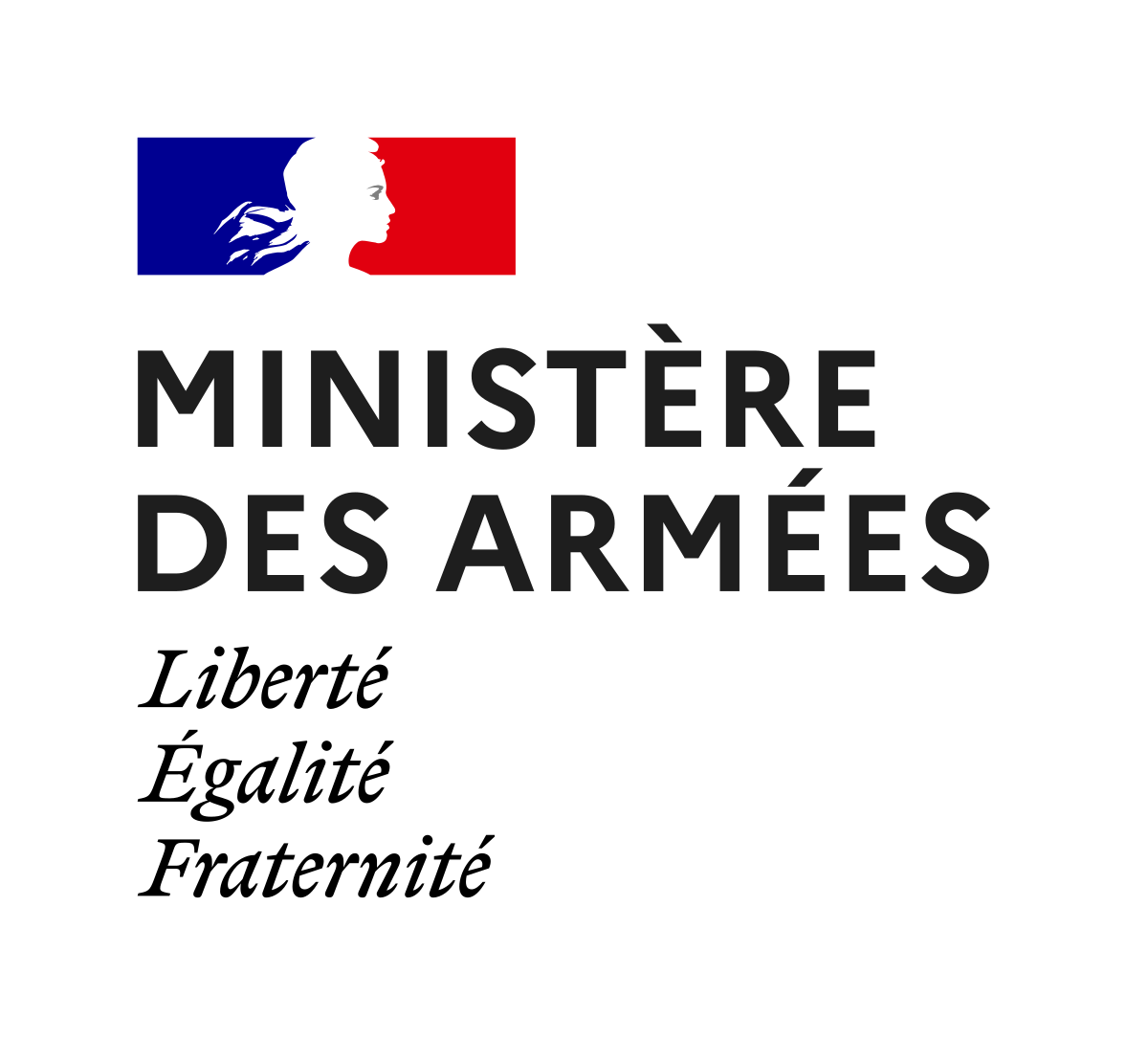
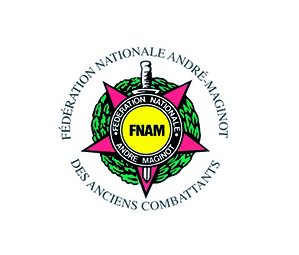
Délégation de Paris
des Amis de la Fondation
pour la Mémoire de la Déportation
31 Boulevard Saint-Germain
75005 Paris
Contact :
afmd75@gmail.com
©AFMD75
Délégation de Paris
des Amis de la Fondation
pour la Mémoire
de la Déportation
31 Boulevard Saint-Germain
75005 Paris
Contact
afmd75@gmail.com
©AFMD75

